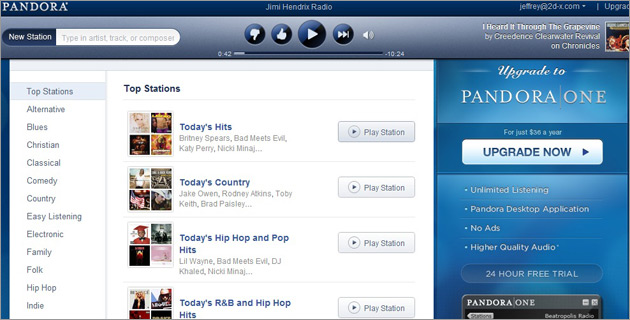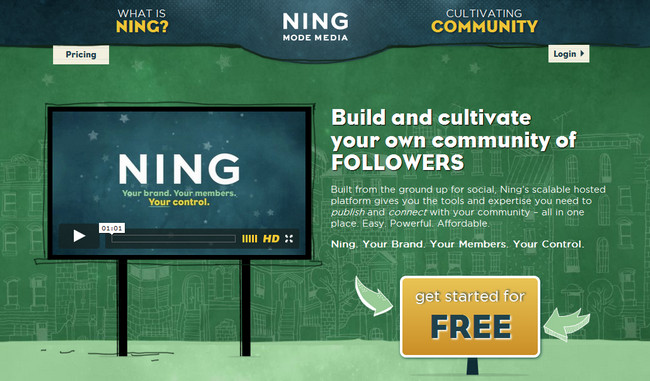Freebie seekers. The very words send a shudder through both product and service-based businesses alike. The worry is that these potential customers will cause a drain on the system – taking, taking, taking without buying. However, with the right approach, this worst case scenario can be avoided significantly, if not completely.
The problem isn’t with your product or service. It’s with the commitment. Free-turned-paid customers want to know that they’re valued and important, and that they have an “escape hatch” if they need it.
If you’re struggling to convert tire-kickers into brand evangelists, try testing the following strategies on your site to swell the ranks of paying customers while building loyalty and user engagement.
1. Offer a Free Trial of the Paid Product, but Do THIS First…
A free trial is one of the oldest and most reliable ways to convert more customers, but your approach is just as important as your offer. Pandora Radio, for example, has plenty of free listeners. Through its partnerships with electronics and car manufacturers, it’s now on virtually every device and newer model vehicle.

Pandora has become synonymous with always-on, available-anywhere internet radio
Of course, customers can listen to the free service, but can opt for a 24 hour trial of the premium service. The premium trial is also available for 7 days through trusted third-party services like PayPal. Many users report that after listening to the improved audio quality (sans ads), they’re hooked, and the lack of interruptions (such as skipping, liking or removing a song) is just icing on the internet radio cake.
Key Takeaway: By partnering with well-known brands, Pandora increased its reach exponentially to become a serious contender in a music space where questionable licensing and royalty fights would have chewed up and spat out even the biggest companies. Even if you can’t rub shoulders with household names, working together with trusted, non-competitive companies in your niche will let some of that trust and credibility they’ve built up, rub off onto you as well.
2. Let Users Chart the Course
One of the best ways to persuade potential customers that your product or service is worth paying for is to invite them to help create it. Case in point: Slate Magazine has some truly vocal and vociferous fans. So, in an era when online magazine and newspaper revenues are shrinking, they went against the grain to try a membership model.

Slate Plus tries a radical departure from typical newspaper and magazine ad monetization methods
Slate Plus shifts the monetization model from ad-based revenue to community-based profits. For a monthly fee, members can help guide the direction of Slate authors and publishers – suggesting interviews, chatting with celebrities and otherwise getting what they’d consider “VIP access” in a community where they already feel comfortable and valued.
Key Takeaway: Your users are the lifeblood of your site. If they’re starting to build a community around your product or service, leverage their loyalty by letting them help shape its direction. This is particularly valuable if you have (or can get) access to people, tools, or other resources that others can’t. It makes your customers feel as if their investment pays off many times over.
3. Become Indispensable
Your goal when converting freebie-seekers is to become integral into their lives, to the point where they actually miss you when they leave. It’s important to remember that people leave for a variety of reasons, no matter how “sticky” your offer is.
Your chance to show your customers the best features of your product shouldn’t wait until they’ve upgraded to a premium version. Right from the start of their free trial, you should be involved – giving them tips on how to make the most of your product or service, as well as providing links to helpful FAQs, customer support and any other tutorials they may need.
When the free trial period is up, spring your best discount on them right away. Don’t wait until the end, as many prospects will be long gone by then. This approach helps you net the majority of buyers who already find your product superior and are just looking for a reason to sign up.
Key Takeaway: For inactive users, always be on the lookout for reasons why they should try your service again. Did you get a phenomenal testimonial from a user? Share it with your list. Mentioned in a prominent media publication? Share it with your list. New feature they’ll love? Share it with your list. Never run out of excuses to stay in touch and remind them on the reasons why your offer is irresistible.
4. Remove the Free Option Completely
This might sound completely counter-intuitive, but in many cases, businesses have seen their paid subscriptions skyrocket as a result of eliminating their free options. Ning is one such example. But how did they fare?

Ning moved from Freemium to a completely paid model
According to Kim Joar Bekkelund, who wrote his master’s thesis on the Freemium model:
Before Ning shut down its freemium offering they had 300,000 free communities, but these only brought in 20% of revenue and 25% of traffic. Ning converted just under 5% of its total user base into paying customers. Skype, on the other hand, have 560 million registered users, of which 124 million use the service each month, and of which 8 million are paying customers. This means that Skype has a 7% conversion rate. Looking at Pandora, Dropbox and Evernote we see conversion rates in the range 0.5% to 4%
When you’re talking about millions of users, that equates to millions of dollars in extra revenue that they may have missed out on if they had stuck to their freemium model.
There are also those users who eventually, at some point in their lifecycle with the company, convert from free to paid, as shown in a presentation by Phil Libin, CEO of Evernote:
The video highlights a number of additional points to consider if you’re involved in the Freemium revenue model, including the value of long-term users, scalability and shifting your business model to focus on new and active users.
Key Takeaway: Switching from free to paid has the potential to upset a lot of users, but chances are, those users weren’t looking to buy from you anyway. By giving existing customers every reason to see why the premium option is a better value, as well as soliciting their suggestions for upgrade perks, you’ll make them feel important and part of the team — which, in a sense, they are.
The Bottom Line on Converting Customers from Free to Paid
A great product and amazing service will carry you far, but there’s a point at which you’ll need to move beyond that. Whether you’re building a community or making the switch from free to paid, don’t leave your users feeling like you jerked the proverbial rug out from under them. Involve them in the process, kindle their enthusiasm and give them every reason to continue wanting to use your product or service.
Not only will you create a legion of brand enthusiasts, but you’ll also increase the viral spread and adoption of your offer with breakneck speed. Good luck!
To see the original article Click Here

No comments:
Post a Comment